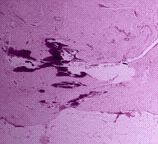Lesions needing biopsy are usually discovered either because they can be felt by a patient or physician or they are visible on a medical imaging examination such as X-ray, Ultrasound, CT scan, MR exam, etc. Screening tests such as pap smear or PSA blood test (prostate specific antigen) can also detect otherwise unknown cancer and lead to biopsy of the appropriate site.
 |
| This pathology image of a breast biopsy specimen shows Hyalinized Calcified Fibroadenoma |
Once an abnormality is found, biopsy is often then used to determine the exact nature of the suspected abnormality. A physician may perform a biopsy as part of cancer diagnosis, in order to determine whether an area of concern is malignant (cancerous) or benign (not cancerous). For example, breast biopsy is the removal of a sample of breast tissue for laboratory (histologic) examination by a pathologist and is the definitive way to determine if an abnormality is cancerous or not. A clinical pathologist is a specially trained physician who performs laboratory analysis of the biopsy specimen (tissue sample) to determine its type.
Microscopic examination of tissue (histology) or cells (cytology) usually gives a correct and definitive diagnosis. In the case of a malignant tumor, biopsies of the surrounding tissue and the lymph nodes can be done to determine whether the cancer has spread (metastasized). In the case of cancer diagnosis, biopsy can also allow the physician to grade the cancer. Another important use of biopsy is to determine the cause of infections or inflammations that can not be explained with other testing.
Surgical biopsy (excisional biopsy) may involve removing the entire mass (tumor) for testing. Biopsy is often done using the guidance of imaging or endoscopy. If cancer is present, a pathologist can usually tell what type of cancer it is and may be able to judge whether the cells are likely to grow slowly or quickly. Click here to go to the section on types of biopsy.
Percutaneous biopsy is routinely done using the guidance of medical imaging (such as ultrasound, mammography or CT imaging). The primary physician, radiologist, surgeon or other physician will determine the most appropriate method of biopsy and guidance based on various factors including:
- the tissue, organ or body part to be sampled
- how suspicious the abnormality appears
- the size, shape and other characteristics of the abnormality
- the location of the abnormality
- the number of abnormalities
- other medical conditions a patient may have
- the preference of the patient, and
- the systems available at a given hospital or healthcare location



